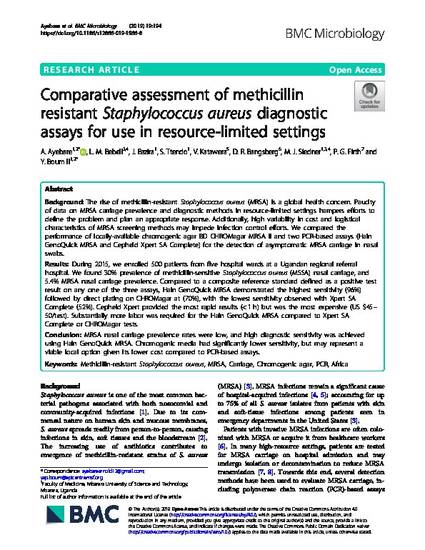
- Bacterial pathogens -- Research
Background: The rise of methicillin-resistant Staphylococcus aureus(MRSA) is a global health concern. Paucity of data on MRSA carriage prevalence and diagnostic methods in resource-limited settings hampers efforts to define the problem and plan an appropriate response. Additionally, high variability in cost and logistical characteristics of MRSA screening methods may impede infection control efforts. We compared the performance of locally-available chromogenic agar BD CHROMagar MRSA II and two PCR-based assays (Hain GenoQuick MRSA and Cepheid Xpert SA Complete) for the detection of asymptomatic MRSA carriage in nasal swabs.
Results: During 2015, we enrolled 500 patients from five hospital wards at a Ugandan regional referral hospital. We found 30% prevalence of methicillin-sensitive Staphylococcus aureus (MSSA) nasal carriage, and 5.4% MRSA nasal carriage prevalence. Compared to a composite reference standard defined as a positive test result on any one of the three assays, Hain GenoQuick MRSA demonstrated the highest sensitivity (96%) followed by direct plating on CHROMagar at (70%), with the lowest sensitivity observed with Xpert SA Complete (52%). Cepheid Xpert provided the most rapid results (< 1 h) but was the most expensive (US $45–50/test). Substantially more labor was required for the Hain GenoQuick MRSA compared to Xpert SA Complete or CHROMagar tests.
Conclusion: MRSA nasal carriage prevalence rates were low, and high diagnostic sensitivity was achieved using Hain GenoQuick MRSA. Chromogenic media had significantly lower sensitivity, but may represent a viable local option given its lower cost compared to PCR-based assays.

© The Author(s). 2019 Open Access This article is distributed under the terms of the Creative Commons Attribution 4.0 International License (http://creativecommons.org/licenses/by/4.0/), which permits unrestricted use, distribution, and reproduction in any medium, provided you give appropriate credit to the original author(s) and the source, provide a link to the Creative Commons license, and indicate if changes were made. The Creative Commons Public Domain Dedication waiver (http://creativecommons.org/publicdomain/zero/1.0/) applies to the data made available in this article, unless otherwise stated.